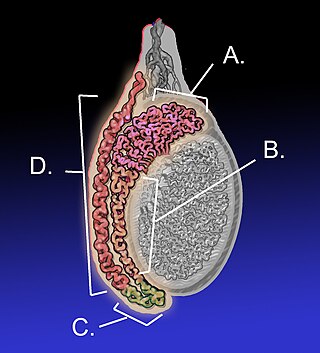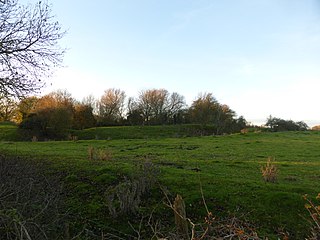Related Research Articles
Per capita is a Latin phrase literally meaning "by heads" or "for each head", and idiomatically used to mean "per person". The term is used in a wide variety of social sciences and statistical research contexts, including government statistics, economic indicators, and built environment studies.

The epididymis is an elongated tubular genital organ attached to the posterior side of each one of the two male reproductive glands, the testicles. It is a single, narrow, tightly coiled tube in adult humans, 6 to 7 centimetres in length; uncoiled the tube would be approximately 6 m long. It connects the testicle to the vas deferens in the male reproductive system. The epididymis serves as an interconnection between the multiple efferent ducts at the rear of a testicle (proximally), and the vas deferens (distally). Its primary function is the storage, maturation and transport of sperm cells.

Caput medusae is the appearance of distended and engorged superficial epigastric veins, which are seen radiating from the umbilicus across the abdomen. The name caput medusae originates from the apparent similarity to Medusa's head, which had venomous snakes in place of hair. It is also a sign of portal hypertension. When the portal vein, that transfers the blood from the gastrointestinal tract to the liver, is blocked, the blood volume increases in the peripheral blood vessels making them appear engorged. It is caused by dilation of the paraumbilical veins, which carry oxygenated blood from mother to fetus in utero and normally close within one week of birth, becoming re-canalised due to portal hypertension caused by liver failure.The appearance is due to cutanous portosystemic collateral formation between distended and engorged paraumbilical veins that radiate from the umbilicus across the abdomen to join systemic veins.

Caput succedaneum is a benign neonatal condition involving a serosanguinous, subcutaneous, extra-periosteal fluid collection with poorly defined margins caused by the pressure on the presenting part of the fetal scalp by the vaginal walls and uterus as the infant passes through a narrowed cervix during delivery.
Robert fitz Martin was a knight from Devon whose father, Martin de Turribus, was the first Norman Lord of Kemes, in what had previously been the Dyfed part of Deheubarth. Fitz Martin inherited the Lordship of Kemes from his father, and founded St Dogmaels Abbey c. 1118. He was the first of the FitzMartin line. His descendants continued to hold lands in England and Wales until the 14th century.

Kendal Castle is a medieval fortification to the east of the town of Kendal, Cumbria, in northern England. The castle, which is atop a glacial drumlin, was built in the 13th century as the Caput baroniae for the Barony of Kendal. By the 15th century, the Parr family owned the castle.

In Norse mythology, Vili and Vé are the brothers of the god Odin, sons of Bestla, daughter of Bölþorn; and Borr, son of Búri.

Cappy is a commune in the Somme department in Hauts-de-France in northern France.
A compound option or split-fee option is an option on an option. The exercise payoff of a compound option involves the value of another option. A compound option then has two expiration dates and two strike prices. Usually, compounded options are used for currency or fixed income markets where insecurity exists regarding the option's risk protection. Another common business application that compound options are used for is to hedge bids for business projects that may or may not be accepted. For related discussion on multi-stage real options – and graphical representation – see Datar–Mathews method for real option valuation.

In heraldry, an achievement, armorial achievement or heraldic achievement is a full display or depiction of all the heraldic components to which the bearer of a coat of arms is entitled. An achievement comprises not only the arms displayed on the escutcheon, the central element, but also the following elements surrounding it :

In the kingdom of England, a feudal barony or barony by tenure was the highest degree of feudal land tenure, namely per baroniam, under which the land-holder owed the service of being one of the king's barons. The duties owed by and the privileges granted to feudal barons are not exactly defined, but they involved the duty of providing soldiers to the royal feudal army on demand by the king, and the privilege of attendance at the king's feudal court, the Magnum Concilium, the precursor of parliament.

Macgowania is an extinct genus of parvipelvian ichthyosaur known from British Columbia of Canada. It was a small ichthyosaur around 3 metres (9.8 ft) in total body length.
Caput lupinum or caput gerat lupinum are terms used in the English legal system and its derivatives. The terms were used in Medieval England to designate a person pronounced by the authorities to be a dangerous criminal, who could thus be killed without penalty.
William de Falaise, also called William of Falaise, was a Norman from Falaise, Duchy of Normandy, today in the Calvados department in the Lower Normandy region of north-western France. He became feudal baron of Stogursey in Somerset and also held manors in Devon.

The feudal barony of Clifford was a feudal barony with its caput baroniae at Clifford Castle in Herefordshire, England.
Caput is an extinct town in Barton County, in the U.S. state of Missouri. The town site is approximately five miles northwest of Lamar.
This article presents a timeline of the name Judea through an incomplete list of notable historical references to the name through the various time periods of the region.
Irthington Castle was a castle located near Irthington, Cumbria, England.

Caput mortuum, also known as cardinal purple, is the name given to a purple variety of hematite iron oxide pigment, used in oil paints and paper dyes. Due to the cultural significance of its deep purple colour, it was very popular for painting the robes of religious figures and important personages, with its popularity peaking in the 18th and 19th centuries.

Folkingham Castle is located near the village of Folkingham, Lincolnshire, England. The castle was the caput baroniae of the barony of Folkingham.
References
- ↑ Michael Aston, Interpreting the Landscape (Routledge, reprinted 1998, page 34)
![]() This article incorporates text from a publication now in the public domain : Chambers, Ephraim, ed. (1728). "CAPUT: Caput Baroniæ". Cyclopædia, or an Universal Dictionary of Arts and Sciences . Vol. 1 (1st ed.). James and John Knapton, et al. pp. 156–7.
This article incorporates text from a publication now in the public domain : Chambers, Ephraim, ed. (1728). "CAPUT: Caput Baroniæ". Cyclopædia, or an Universal Dictionary of Arts and Sciences . Vol. 1 (1st ed.). James and John Knapton, et al. pp. 156–7.